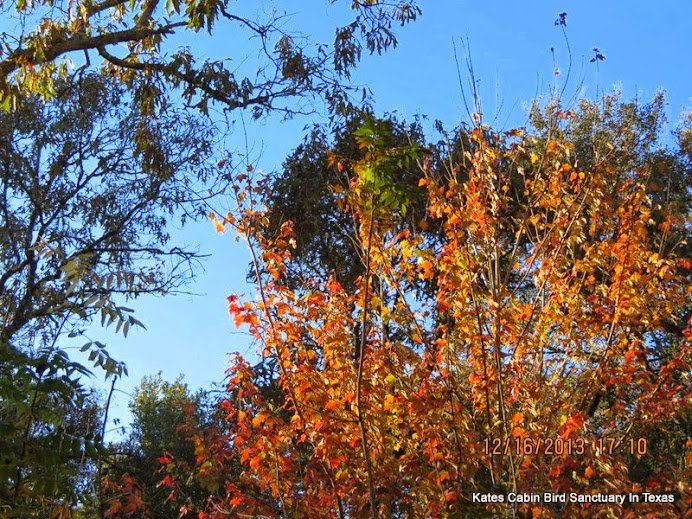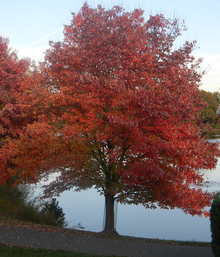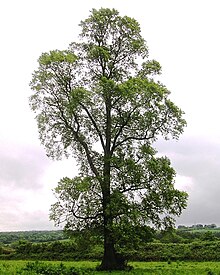
Hi Everybody!!
This will be the last show of Fall Color in the trees for 2013. The leaves are falling pretty fast now. By morning we will have high winds and tornado watch with chance of heavy thunder storms. This Big Blow will likely take the remaining leaves down. A short burst of color in December, but Spectacular! Below you will find links to the photostudies in the albums on G+. Also, I have shared info from Wikipedia on the 3 trees I have featured tonight. I encourage you all to plant more trees! Enjoy!

https://en.wikipedia.org/wiki/Acer_rubrum
Acer rubrum
From Wikipedia, the free encyclopedia
Acer rubrum (Red Maple, also known as Swamp, Water or Soft Maple), is one of the most common and widespread deciduous trees of eastern North America. The U.S. Forest service recognizes it as the most common variety of tree in America.[3] The red maple ranges from the Lake of the Woods on the border between Ontario and Minnesota, east to Newfoundland, south to near Miami, Florida, and southwest to east Texas. Many of its features, especially its leaves, are quite variable in form. At maturity it often attains a height of around 15 m (49 ft). It is aptly named as its flowers, petioles, twigs and seeds are all red to varying degrees. Among these features, however, it is best known for its brilliant deep scarlet foliage in autumn.
Over most of its range, red maple is adaptable to a very wide range of site conditions, perhaps more so than any other tree in eastern North America. It can be found growing inswamps, on poor dry soils, and most anywhere in between. It grows well from sea level to about 900 m (3,000 ft). Due to its attractive fall foliage and pleasing form, it is often used as a shade tree for landscapes. It is used commercially on a small scale for maple syrupproduction as well as for its medium to high quality lumber. It is also the State Tree of Rhode Island.
| Acer rubrum | |
|---|---|
 | |
| Conservation status | |
 Secure (NatureServe)[1] | |
| Scientific classification | |
| Kingdom: | Plantae |
| (unranked): | Angiosperms |
| (unranked): | Eudicots |
| (unranked): | Rosids |
| Order: | Sapindales |
| Family: | Aceraceae[2] |
| Genus: | Acer |
| Species: | A. rubrum |
| Binomial name | |
| Acer rubrum | |
Description[edit]
Though A. rubrum is usually easy to identify, it is highly changeable in morphological characteristics. It is a medium to large sized tree, reaching heights of 18 to 27 metres (59 to 89 ft) and exceptionally over 35 metres (115 feet). The leaves are usually 9 to 11 centimetres (3.5 to 4.3 in) long on a full grown tree. The trunk diameter can range from 46 to 76 cm (18 to 30 in), depending on the growing conditions.[4] Its spread is about 12 m (39 ft). A 10-year-old sapling will stand about 6 m (20 ft) tall. In forests, the bark will remain free of branches until some distance up the tree. Individuals grown in the open are shorter and thicker with a more rounded crown.[5]Generally speaking, however, the crown is irregularly ovoid with ascending whip-like curved shoots. The bark is a pale grey and smooth when the individual is young. As the tree grows the bark becomes darker and cracks into slightly raised long plates.[6] The largest known living red maple is located near Armada, Michigan, at a height of 38.1 m (125 ft) and a bole circumference, at breast height, of 4.95 m (16.2 ft).[4]
The leaves of the red maple offer the easiest way to distinguish it from its relatives. As with nearly all maple trees, they are deciduous and arranged oppositely on the twig. They are typically 5–10 cm (2.0–3.9 in) long and wide with 3-5 palmate lobes with a serrated margin. The sinuses are typically narrow, but the leaves can exhibit considerable variation.[5] When 5 lobes are present, the three at the terminal end are larger than the other two near the base. In contrast, the leaves of the related silver maple,A. saccharinum, are much more deeply lobed, more sharply toothed and characteristically have 5 lobes. The upper side of A. rubrum's leaf is light green and the underside is whitish and can be either glaucous or hairy. The leaf stalks are usually red and are up to 10 cm (3.9 in) long. Furthermore, the leaves can turn a brilliant red in autumn, but can also become yellow or orange on some individuals.
The twigs of the red maple are reddish in color and somewhat shiny with small lenticels. Dwarf shoots are present on many branches. The buds are usually blunt and greenish to reddish in color, generally with several loose scales. The lateral buds are slightly stalked, and in addition there may be collateral buds present as well. The buds form in fall and winter and are often visible from a distance due to their reddish tint. The leaf scars on the twig are V-shaped and contain 3 bundle scars.[5]
The flowers are generally unisexual, with male and female flowers appearing in separatesessile clusters, though they are sometimes also bisexual. They appear in spring from April to May, usually coming before the leaves. The tree itself is considered Polygamodioecious, meaning some individuals are male, some female, and somemonoecious.[4] The red maple will begin blooming when it is about 10 years old. The flowers are red with 5 small petals and a 5-lobed calyx borne in hanging clusters, usually at the twig tips. They are lineal to oblong in shape and are pubescent. The pistillate flowers have one pistil formed from two fused carpels with a glabrous superior ovary and two long styles that protrude beyond theperianth. The staminate flowers contain between 4 and 12 stamens, often with 8.[7]
The fruit is a 15 to 25 millimeter (.5 to .75 inch) long double samara with somewhat divergent wings at an angle of 50 to 60 degrees. They are borne on long slender stems and are variable in color from light brown to reddish.[5] They ripen from April through early June, before even the leaf development is altogether complete. After they reach maturity, the seeds are dispersed for a 1 to 2 week period from April through July.[4]


link to Red Maple Tree Album:
https://plus.google.com/u/0/photos/117645114459863049265/albums/5959533678876223233


https://en.wikipedia.org/wiki/Elm
Elm
From Wikipedia, the free encyclopedia
Elms are deciduous and semi-deciduous trees comprising the genus Ulmus in the plant family Ulmaceae. The genus first appeared in the Miocene geological period about 20 million years ago, originating in what is now central Asia.[1] These trees flourished and spread over most of the Northern Hemisphere, inhabiting the temperate and tropical-montane regions of North America and Eurasia, ranging southward across the Equator into Indonesia.
Elms are components of many kinds of natural forests; during the 19th and early 20th centuries, many species and cultivars were also planted as ornamental street, garden, and park trees in Europe, North America, and parts of the Southern Hemisphere, notablyAustralasia. Some individual elms reached great size and age. However, in recent decades, most mature elms of European or North American origin have died from Dutch elm disease, caused by a microfungus dispersed by bark beetles. In response, disease-resistant cultivars have been developed, capable of restoring the elm to forestry andlandscaping.
Elm leaves are alternate, with simple, single- or, most commonly, doubly serratemargins, usually asymmetric at the base and acuminate at the apex. The genus ishermaphroditic, having apetalous perfect flowers which are mostly wind-pollinated, although bees do visit them. The fruit is a round wind-dispersed samara flushed withchlorophyll, facilitating photosynthesis before the leaves emerge.[2] All species are tolerant of a wide range of soils and pH levels but, with few exceptions, demand good drainage.
| Elm | |
|---|---|
 | |
| Narrow-leafed Elm Ulmus minor subsp minor
East Coker, Somerset, UK.
| |
| Scientific classification | |
| Kingdom: | Plantae |
| (unranked): | Angiosperms |
| (unranked): | Eudicots |
| (unranked): | Rosids |
| Order: | Rosales |
| Family: | Ulmaceae |
| Genus: | Ulmus L. |

link to elm tree album:
https://plus.google.com/u/0/photos/117645114459863049265/albums/5959571904353445185


https://en.wikipedia.org/wiki/Quercus_shumardii
Quercus shumardii
From Wikipedia, the free encyclopedia
| Shumard Oak | |
|---|---|
 | |
| Leaves of a Shumard Oak in Austin, Texas | |
| Conservation status | |
 Secure (NatureServe)[1] | |
| Scientific classification | |
| Kingdom: | Plantae |
| (unranked): | Angiosperms |
| (unranked): | Eudicots |
| (unranked): | Rosids |
| Order: | Fagales |
| Family: | Fagaceae |
| Genus: | Quercus |
| Section: | Lobatae |
| Species: | Q. shumardii |
Description[edit]
Mature Shumard Oak typically reach heights of 25 to 35 meters (82 to 115 ft), trunkdiameter is typically 60 to 100 centimeters (24 to 39 in), and crown width typically reaches 12 to 18 meters (39 to 59 ft) in width. Typical size varies according to region, with larger specimens occurring in the southern portions of its native range in the United States. Record Shumard Oaks have been measured at up to 42 meters (138 ft) tall, with crowns up to 27.5 meters (90 ft) in width. Young specimens generally exhibit conic orovate crowns, with the upper crown filling in as the tree reaches maturity. Trunks are relatively straight and vertical.
The young bark of the Shumard Oak is light grey, very smooth, and very reflective. Shumard Oak bark darkens and develops ridges and furrows as it ages. There are occasionally white splotches on the bark.
Shumard Oak twigs terminate in a cluster of buds. The buds are lighter in color than the olive-green twigs. The young twig is highly reflective.
The leaves are arranged alternately and are broadly obovate with 5–9 lobes, each of which are terminated by bristle tipped teeth. The leaves mature to between 10 to 21 centimeters (4 to 8 in) in length. The surfaces are glabrous, except for the tufted vein axils. They are dark green on the top, while the bottom is a slightly lighter shade of green. The leaves turn brown to red in the fall, and sometime have hues of yellow mixed in. Fall colors are relatively late; specimens in central Texas may be at their most red in early December, while Florida specimens may not color substantially until February.
Shumard Oak bears relatively large acorns, which typically reach up to 3 centimeters (1 in) in diameter. Acorns take between 1.5 and 3 years to fully mature, and may go unnoticed during their early stages of development.
The acorns of the Shumard Oak provide food for various songbirds, game birds such as wild turkey and quail, waterfowl, white-tail deer, feral hogs, and various rodents such as squirrels. The leaves and twigs can also provide browse for white-tail deer.

link to red oak album:
https://plus.google.com/u/0/photos/117645114459863049265/albums/5959574539300118881

...this is brendasue signing off from Rainbow Creek. See You next time. The Fall Color for this year has ended. Tonight the big blow comes in and all the rest of the leaves will fall. A short time of color, but Spectacular in my yard!

O+O





No comments:
Post a Comment
Hi Everybody! Please say hello and follow so I know you are here! Due to the inconsideration of people trying to put commercials on my blog comment area, I have restricted use of anonymous posts. Sorry that some hurt all.
My public email is katescabin@gmail.com No spammers or trolls